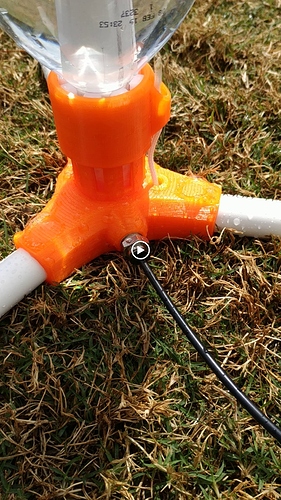Working on a 3d printed water rocket launcher. Rockets next!!
The idea here is to pipe air from an off the shelf pressure line fitting to the launch tube, through which the bottle is pressurised.
I was expecting either it would work, or fail catastrophically.
Interestingly it did fail, but his it failed was kind of cool.
If seems the internal printed air duct failed and pressurised the main body from the inside.
The top surface is gently conical and the weak point where the air escapes, is between the stepped layers.
There are 5 top and bottom layers and 4 perimeters.
I would have though it would be enough but there are tiny, evenly spaced air ducts that allow air out.
At 100psi the pressure in the system drops very very slowly as the air finds its way through the print.
I wonder if the concept has any hope.
I figured a 1.5mm duct, even at high pressure wouldn’t have enough power to do any damage if it didn’t work, but pressurising the larger volume of the foot… Increases the risk too much think.
What material is this?
This seems like a perfect job for PETG.
Two recommendations: 1 - inspect/fix any non-manifold parts - these would be hidden flaws in your 3d model that may allow water/air to seep out. See this and other sources: https://www.lifewire.com/repairing-3d-files-with-meshmixer-2290
2 - Also if this is PLA, look into “heat annealing” your printed parts - by using low heat over time, you can “bake” the PLA layers to be tougher and possibly seal any holes caused by under-extrusion or other printer-related micro-gaps. https://www.youtube.com/watch?v=CZX8eHC7fws
Good luck!
@Christopher_Gaul
The material is transparent orange esun Petg. By far my favourite material.
I suspect though the way the Petg lays up, it leaves tiny channels and the air bleeds between the layers.
@Christopher_Leger I think the part file should be ok, I exported direct from Solid Edge. Checking paths after slicing it all looks nice and neat.
The part itself is primo. It’s just interesting that it allows air through the layers at high…ish pressure.
You need better between-layer adhesion and maybe more material extruded too. I would try to play with slicer settings: increase extrusion rate, slow down the speed and maybe increase temp a bit. These may also impact the quality look though.
BTW I like the design… Having made lots of PVC rockets over the years, this would be nice.
@Cameron_Spiller I agree with @Christopher_Leger if this is PETG then you shouldn’t have these layer adhesion issues.
Is your part cooler fan off, it should be.
Is your print speed slow enough?
Print temp high enough?
Keep us posted. This is interesting seeing 3D Printed parts pushed like this.
Is there actual layer separation like people seem to be assuming or is it just a matter of print porosity? FFF parts are going to be porous, you can fight that a bit with extra layers and perimeters and overextrusion and printing a bit hotter but 100psi is nearly 7 atmospheres of pressure. Air is going to find the gaps between beads. You will want to seal it all with an epoxy inside and out.
@Jeff_DeMaagd yes that’s right. It seems to be a very minor porosity, and mainly in that top gently sloping surface where layers are stepped… So not continuous.
The previous prototype failed due to the force of the rocket pushing down on the launch tube, and it literally shattered a piece of the Petg launcher out. That was a design flaw though. The way the legs were arranged meant there was heaps of leverage on the sockets where the legs were plugged in.
I think running hotter (I’m at 240 now), and slower (already slow at 50mm/sec) and over extruding should fill that porosity.
How much pressure can it take and the risk of a catastrophic failure?? Might be safer to stick to pressure rated tubing…
@Christopher_Leger by pvc do you mean hybrid NOS?? Do tell!!
I’ve never seen ABS + acetone, PETG, or any other material hold more than 20 to 30 psi, even with epoxy coating (west marine 105, 2 coats.) Printed parts for sealing pressure, via FDM, seems a challenge. There was a paper that had similar results years ago, I think from somewhere in Texas?
@Anthony_White there’s a LOT of FDM materials research going on these days and today’s materials are vastly improved over yesterday’s. It’s likely any research or testing done on this is already out of date.
Now that 3D printing has crossed a certain threshold, we’re no longer grabbing off the shelf thermoplastics and adapting to their strengths and weaknesses. Now materials are being custom engineered to fit the task and the FDM assembly methods.
This will be interesting then. It’s pla and will get 110psi tomorrowhttps://profiles.google.com/photos/116055096952392900151/albums/6600988847315320321/6600988852325908098
@Christopher_Gaul Cool… any proof? I’d love to try and replicate…
@Anthony_White proof? Go filament shopping.
The shelves are rife with new, engineered and modified materials with more released all the time.
@Anthony_White when I get it all working, I’ll stick the files on thingiverse and be sure to let you know.
The goal is 100m altitude from a 1.25L coke bottle.
Altimeter is in the mail.
But to hit that I need to hold 120 psi.
I’d be careful going above 100 psi - especially if you plan to reuse the bottles. I’ve gotten above 120, but also have seen failures at 100psi or even lower if there are any wrinkles in the bottles.
@Christopher_Gaul well sure… but none of those materials advertise being air (or water) pressure proof when printed, as far as I’m aware?
I’ll be quite impressed if @Cameron_Spiller gets above 30psi, but I hope he does!
@Anthony_White no but many advertise increased strength and/or improved layer bonding.
For example, read the description here.
My guess is that this project will require something like the Taulman 910 or similar.
